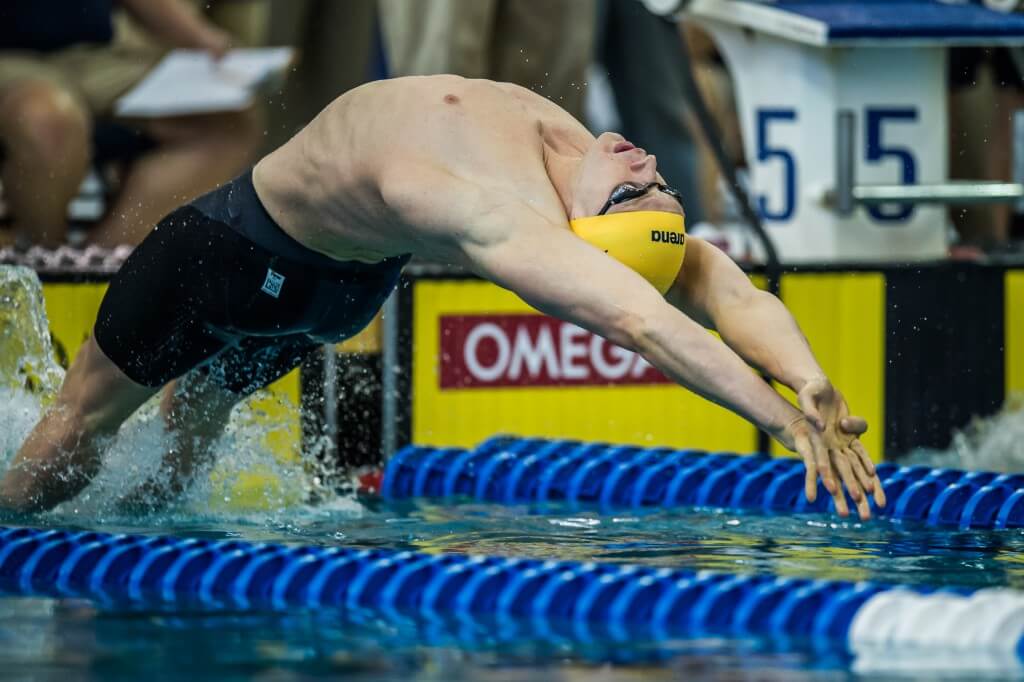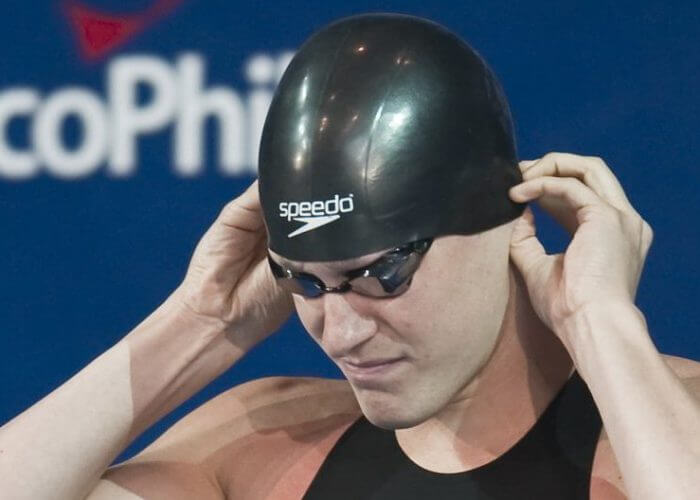Why Didn’t The Super-Suit Era Affect College Swimming?

By Jason Tillotson, Swimming World College Intern
We all know how devastating of a blow the international swimming world took after the ban on polyurethane “super” suits. In 2009 alone, 147 world records were broken in super-suits (43 of those records were written at the 2009 LC World Championships). In 2010, after the ban, the world record tally went down to single-digits.
The recovery period took longer than some expected, with world and regional records coming few and far between, making them seem more impressive and merited. Ryan Lochte’s 400 I.M. at the 2010 SC World Championships in Dubai and Missy Franklin‘s 200 backstroke at the 2012 London Olympic Games are two good examples of records that came once in a blue moon because they were one of few world records at those championships.
However, the effects of the super-suit ban seemed to only reach the pros and not the college athletes. After the ban, collegiate swimmers broke several records by substantial margins, which catapulted the the level of NCAA competition higher than ever before (most notably Cesar Cielo becoming the first man to swim a 50-yard freestyle in 18.5 seconds and Elaine Breeden becoming the first woman to swim under 1:50 for a 200-yard butterfly).
On the Division I men’s side, out of the 19 total events, only three records are from 2009 or sooner (one of them being Peter Vanderkaay’s 4:08 500 free, which has been holding on for dear life due to the likes of Townley Haas and Clark Smith). On the Division I women’s side, only two of the 19 total records are from the super-suit era.

Photo Courtesy: Peter H. Bick
Aside from Division I records, the entire NCAA (Div. I, II and III) has seen major decreases in the ‘A’ qualification standard. For example, in Divisions I and II, for this upcoming 2016-2017 season, the ‘A’ cut was lowered in nearly every event and in cases which the standard was not lowered, it was not raised. A prime example of this can be seen in the women’s Division II 200 I.M. and 200 breaststroke, where the A cut was lowered by over a full second. Similar trends have been seen in previous years which indicates that the super-suits were nothing but a fashion trend, rather than a necessity for swimming fast.
But the question still remains, why didn’t the super-suit ban plague the college swimming community as much as it did the international community? The answer is two-fold.
On one hand, it could be due to the fact that college swimmers are still very young, in comparison to the average age of the U.S. Olympic Team, and therefore have more room to grow and get faster, which would explain why so many of the NCAA records are relatively new. Although, a more precise reason may be the fact that the most dominate college swimmers today (Caeleb Dressel, Joseph Schooling, Lilly King, Simone Manuel, etc.) were too young to fully experience the polyurethane suits, during their careers, thus causing no relationship between using them and swimming fast.
To put it into perspective, in 2009, Caeleb Dressel and Joseph Schooling were still competing in the 13-14 age group. Lilly King was 11 years old and Simone Manuel was only 12. The suits were not manufactured until 2008, which means the age-group versions of our college swimming stars today, only had one or two real, end of the season opportunities to use these super-suits, if they were lucky, which means they never developed a sense of what the suits truly felt like.
Another prime example of how the suit ban didn’t affect college athletes is Ryan Murphy’s 51.85 100-meter backstroke world record performance from the 2016 Olympic Games. Aaron Piersol previously held the record with a 51.90, but it was produced in a polyurethane suit. Murphy, a senior at University of California-Berkeley, proves to us that the super-suits never played a pivotal role in the progression of NCAA competition.
This shows us that the full effects of the suit ban didn’t make their way to the college athletes. Murphy and all the other NCAA stars from all divisions, will compete in their respective championships again this spring and will have another chance to further push the boundaries past those of super-suit era. Only time will tell when the international community will catch up.
All commentaries are the opinion of the author and do not necessarily reflect the views of Swimming World Magazine nor its staff.




The suits definitely did not have as much of a lasting impact as expected in college but they did have a huge impact at the time.
For example, on the men’s side 9 swimmers hit a flat start 18 second 50 freestyle that year. 5 guys did it this year. In the 100 fly 3 swimmers swam 44s in 2009 which didn’t happen again until this year.
I think it mostly has to due with age group kids developing underwaters today. They come into college with that skill already. In addition to having some big time talents in the college ranks, the earlier development of underwater kicking is what has allowed college times to keep getting faster.
But college swimming did after the ban decrease the allowed number of competitors at D2 Nationals as very few competitors actually make A cuts. In 2011 my teammate was one of 4 swimmers who made an A cut in the 400 IM.
I believe your first sentence should read:
“We all know how devastating of a blow the international swimming world took after FINA, without proper testing of the suits, without a trial period in major competition, without input from coaches and swimmers on the new suits simply appeared to authorize their use.”
I am not confident that FINA has the very best interests of the sport in mind when decisions of this magnitude are made.
Very well written article. I think once the suits were taken away, psychologically the swimmers who used them before felt deprived.
Yeah the suit ban didn’t really affect the college athletes that much. All the evidence you produced strengthens the claim.
I feel that the answer is in the math if you consider the following relationship.
1) You can swim a lot faster when float higher in the water.
2) You can maintain a start and turn speed, that is faster than what you can swim at the surface, by kicking underwater.
So the question to ask is: “Is it better to wear a suit that helps you float better?”
The answer depends on the course you are swimming.
In a 25 yard pool you can swim 65.6% of the most races underwater. In a 25 meter pool you can swim 60% underwater. In a 50 meter pool you can swim 30% of the race underwater.
A buoyant suit will not help your underwater speed and may actually hurt, but will help your on surface speed.
There certainly are a lot of other factors involved including 25 meter world records (not as heavily contested by US athletes), breaststroke records (most changing technique of all strokes), increased size and strength of athletes each year (except Anthony Ervin 2000 and 2016), performance enhancing drugs (???). But, the percentage of underwater kicking vs actual swimming probably plays a part as to why NCAA swimming was not affected as much.
Best explanations I’ve heard.
Cielo’s 50 free was in 2008, and I’m pretty sure he was wearing a rubber suit. I could be wrong, but I was at the meet watching.
I THINK that the NCAA allowed the fast suits that were worn in the 2008 Olympics, but not the absurdly fast suits that were worn at the 2009 Worlds. If so, this would probably explain why the suits did not affect NCAA records as much as the world records.